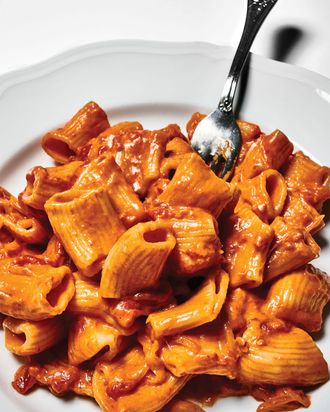
Besides fettuccine Alfredo, is there a dish reviled by pasta snobs as much as penne alla vodka? The other day, one of these detractors summed up the recipe for us as follows: Bring a large pot of water to a roiling boil, add salt, toss in penne, and cook until al dente. Meanwhile, in a small pot, heat up a can of cream-of-tomato soup. Drain pasta. Dump soup over pasta. Mangia!
Although the pasta snob was just being extra snooty and probably secretly craves the stuff, he wasn’t so far off the mark. The problem with vodka sauce is the inherent simplicity of the recipe: just onions, garlic, crushed red pepper, a slug of vodka, tomatoes, and heavy cream. And the trouble with simple recipes, as everyone knows, is that they’re the most difficult to get right. Which might be why it seems that lousy penne alla vodkas (soupy, bland) outnumber outstanding penne alla vodkas (tangy, balanced) by such a wide margin. (Though we’d argue that like pizza and mashed potatoes, the dish belongs to that superb group of comfort foods that fall under the heading Good Even When Bad.)
Maybe penne alla vodka’s standing in the pasta hierarchy wouldn’t be so low if it had a more inspiring origin story. Some say it was invented at Dante restaurant in Bologna in the ’80s; others say it was Orsini’s in New York at about the same time. But the chef and Italian-food guru Cesare Casella remembers wolfing plates of midnight penne alla vodka at the clubs and discos on the Versilia coast in Tuscany in the late ’70s, attributing its presence to vodka-company marketing schemes. A story like that could make any pasta doubt its authenticity and cause it to develop an inferiority complex. Which is why we think critics shouldn’t be so hard on the dish.
The good news is that pasta alla vodka and vodka sauce itself are enjoying some degree of hipster celebrity with today’s reclamation of all things retro at restaurants like Carbone, where a $26 plate of “spicy rigatoni vodka” has become one of those signature dishes whose removal from the menu would provoke a pitchfork-and-torches-level revolt by the restaurant’s regulars. Vodka sauce — a.k.a. pink sauce, which in truth ranges in color from pale salmon to sunset orange — is a mainstay of the city’s enduring red-sauce joints, but you can also find it at fast-casual-pasta newcomers Aunt Jake’s and the Sosta, and as a pizza topping everywhere from Staten Island’s venerable Joe & Pat’s, which spawns an East Village outpost this winter, to Old Rose, the new restaurant at the Jane Hotel, where chef Joey Scalabrino uses legendary pizza man Chris Bianco’s proprietary canned tomatoes for his vodka-sauce-and-Stracchino-cheese pie.
This newfound popularity doesn’t come without some degree of controversy. Italians can get weird and testy when the subject of combining tomatoes and cream (or dairy in general) is brought up for debate. “You’re blending the two worlds of Italian cuisine in a pan: The southern Italians with their tomatoes and the northern Italians with their cream,” explains Carbone’s Mario Carbone. “Neither one of them wants to be associated with the other and it just pisses them off.” He’s right. Neapolitans, for instance, obsess over pizza Margherita (super-creamy blobs of buffalo mozzarella dotting a tomato-sauced dough), but the idea of adulterating their prized pomodori with acid-muffling butter or cream is loathsome to them. Asking a Neapolitan to add cream to tomato sauce is like asking a Scotch whisky aficionado to cut a 20-year-old single malt with a splash of Mountain Dew. “I’d never heard of penne alla vodka until I came to this country,” says Rosario Procino, the Naples-born co-owner of the downtown pizza restaurant Ribalta. “And when I did hear about it, I refused to try it.”
Tuscans seem to be less fussy about mixing tomato with cream: Pino Luongo had an early hit with his rigatoni alla buttera, a dish he’ll bring to the latest version of his Coco Pazzo restaurant when it opens in Soho this fall; and the rigatoni Pitti and pappardelle alla Fiesolana are two of the best sellers at Giovanni Tognozzi’s Bar Pitti.
But therein lies the rub: None of those dishes are called alla vodka or even contain the spirit. And neither — prepare yourself for a shocker — does Carbone’s, despite what they call it on the menu. “I tried the recipe with varying amounts of vodka in it and it didn’t do anything,” says the chef. Indeed, the recipe’s success, says Carbone, can be attributed to flavor builders and texture boosters like onion soubise, good tomatoes, chewy housemade pasta, and high-octane Calabrian chile paste. Why then call it “spicy rigatoni vodka” instead of, say, “pasta a pomodori e panna”? “Because that’s how people have come to know the dish.”
Not everyone shares Carbone’s opinion. In his assiduously researched The Food Lab, J. Kenji López-Alt, citing Harold McGee on the effect of reactive molecules in alcohol on food and other beach-read theories, claims that vodka, though not compulsory, does contribute to the dish’s fragrance and flavor, concluding that “vodka sauce wouldn’t be, well, vodka sauce without it.” Except of course when it is.
Vodka or no, Italian or Italian-American, the bastard child of mismatched regional cuisines or the misbegotten fruit of a liquor ad: The one incontrovertible truth about pasta alla vodka is that when done well, it’s soul-soothingly delicious, with a tangy lushness and just enough of a chile-pepper pop to make you want to keep eating it. As the song says: if loving vodka sauce is wrong, we don’t want to be right.
*A version of this article appears in the October 2, 2017, issue of New York Magazine.




